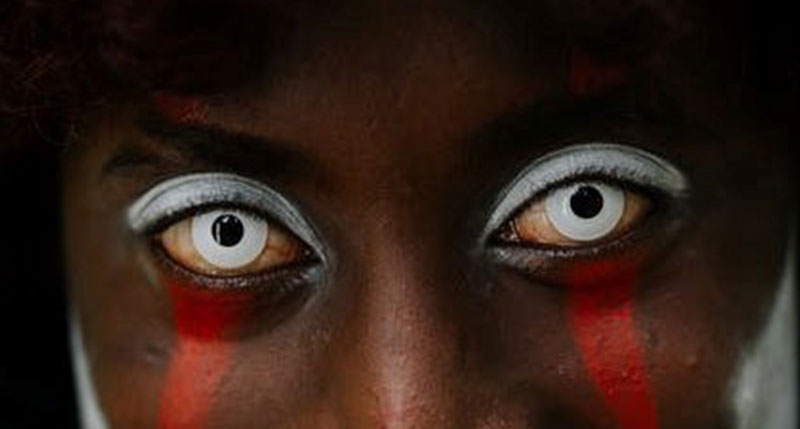It’s Halloween season! It’s also the time of year when optometrists worry about their patients risking eye safety and injury from using illegal medical devices during Halloween celebrations.
Which illegal medical devices are we talking about? Contact lenses. Specifically, the large array of costume contact lenses that make eyes look incredibly creepy and spooky—but that can also leave you with life-changing damage to your eyesight.
Beware of Halloween Contact Lenses
These cosmetic contact lenses are all over the internet and in local stores. They claim to be legal and FDA approved—but when they’re sold without a prescription, they’re illegal. Such lenses go by a variety of names, including:
- Costume Contact Lenses
- Cosmetic Contact Lenses
- Decorative Contact Lenses
- Theatrical Contact Lenses
- Color Contact Lenses
- Halloween Contact Lenses
The lenses themselves are indeed creepy. Wearing them can make it look like you don’t have a pupil, change your iris color, or make it seem like your eyes are a total blackout or total whiteout. But at what cost?
Though these contact lenses don’t correct vision impairment, they are medical devices. By law in the United States, all medical devices require a prescription to ensure that they are dispensed with the oversight of a doctor or eye care professional.
Put Eye Safety First
For your own safety and to protect your precious vision, costume contact lenses should not be dispensed without the supervision of your optometrist. Buying costume contact lenses on the internet, or from a flea market, or in a Halloween costume store puts you at risk for a variety of eye infections and injuries that could permanently damage your eyes and cause partial or total blindness.
The American Optometric Association (AOA) puts patient safety at the top of its priority list by exposing “illegal retailers and counterfeiters sidestepping legal requirements that protect patients’ eyes.” The AOA is taking steps to help the US Food and Drug Administration (FDA) protect patients from the dangers of costume contacts.
Risks of Costume Contact Lenses
Last year, in the fall season of 2020, there were multiple reports of patients visiting their optometrists after wearing Halloween contact lenses. These patients suffered from infections, corneal scratches, keratitis, conjunctivitis, and were at risk for permanent vision loss—despite having practiced good contact lens hygiene.
Because they do not adhere to FDA regulations and therefore may contain harmful contaminants and may not fit your eye’s surface smoothly, costume contact lenses can put your eyes at risk for:
- Corneal abrasions and corneal scratches
- Infection
- Red, irritated, itchy, watery eyes
- Decreased vision
- Partial or total blindness
Remember: it is illegal to dispense contact lenses without a prescription in the United States—a law that was enacted to protect your eye health and vision.
It’s simply not worth risking a lifetime of good vision to look creepy at one Halloween party or event. As your eye doctor, we strongly advise you to say no to costume contact lenses obtained without a prescription.
Contact lenses are medical devices, and can be an effective and safe way to correct vision when used under the care and guidance of your optometrist or other eye care professional. However, when sold without a prescription by retailers who don’t hold a patient’s eye health as their number one concern, costume contact lenses can be dangerous and have the potential to inflict long-term damage to your vision.
Always follow your optometrist’s advice for the care, wearing, cleaning, and disinfecting of your contact lenses. If you experience redness, pain, or have discharge from your eyes, call your optometrist immediately or seek medical care.





